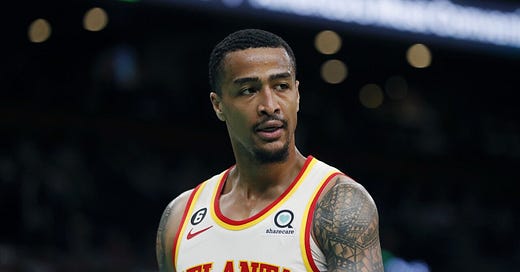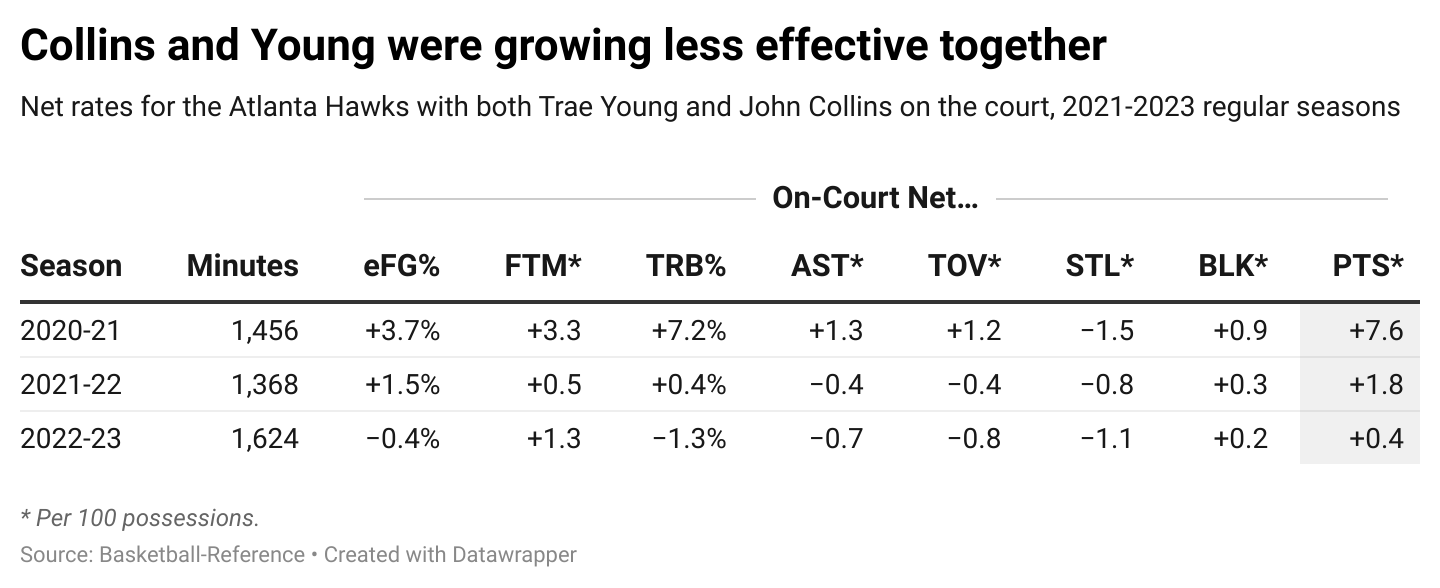The Curious Case Of John Collins
The Hawks sold low on Collins, whose promise inexplicably vanished in 2 seasons.
The Atlanta Hawks are a confusing — and seemingly confused — franchise right now. After unexpectedly making the conference finals in 2021, the team has regressed in winning percentage for two consecutive seasons (from .569 to .524 to .500) and was outscored by a grand total of 92 points in 11 games across a pair of first-round losses. Along the way, Atlanta has tried a number of big moves to build around Trae Young as the centerpiece of its roster — including multiple coaching changes, a high-profile trade for Dejounte Murray last summer and an in-season deal for Saddiq Bey in February. None have especially succeeded, in the sense that the Hawks are no closer to finding the right formula for accentuating Young’s positives and mitigating his negatives than they were a few years ago.
But the other ingredient to the Hawks’ ascent was supposed to be young forward John Collins, who seemed like he was on his own All-Star trajectory as a solid No. 2 option whose all-around game could complement Young’s skills. After years of deterioration, that hope finally ended for good this week when the Hawks shipped Collins to the Utah Jazz for… basically nothing (they get old Rudy Gay, a second-round pick and a huge trade exception that probably won’t end up being overly useful). Though the Hawks’ front office has an affinity for these lopsided cost-cutting moves, and they probably could have gotten far more for Collins if they’d dealt him earlier, the trade also spoke to just how much — and how shockingly — Collins’ star had fallen over the past few seasons.
In 2020-21, during his age-23 season, Collins had a Consensus Plus/Minus of +3.0 — fifth-best among all NBA forwards aged 25 or younger with at least 1,500 minutes played (trailing only Zion Williamson, Michael Porter Jr., Mikal Bridges and Jayson Tatum). He had just improved his rating for the third consecutive season, and had unanimously above-average marks in the advanced metrics while showing good chemistry with Young (the Hawks had a +7.6 net rating with both sharing the floor). Although his numbers had faded a bit in the playoffs, Collins’ steady growth and developing skillset earned him a 5-year, $125 million contract extension from the Hawks in August 2021.
If the history of similar young players was any indicator, this was going to be money well spent. I found all players (regardless of position) who had the most similar arc1 of qualified seasons by CPM from ages 21-23, and the list is an impressive menagerie of good-to-great players who almost all continued their upward trajectories at ages 24-25.
Aside from the blip of a negative year for Stephon Marbury at age 24 (the first season after he was dealt from the New Jersey Nets to the Phoenix Suns for Jason Kidd — you can read a little about that in my essay about the Kidd-era Nets here), every other player in this group posted a positive CPM at ages 24 and 25, except Collins. On average, they continued to improve a bit in each of those seasons… but Collins declined sharply and then kept declining.
His rapport with Young was also fading. After ranking among Atlanta’s best and most well-used 2-man combinations in 2020-21, Collins and Young were one of its least effective qualified pairs in 2021-22, and the team hardly broke even with the duo sharing the court in 2022-23 (granting that the Hawks’ collective net rating was also barely above water all regular season).
Why had Collins’ performance and fit soured within the Hawks’ roster and system? It’s hard to definitively say; the long-lasting trade rumors couldn’t have helped. But an emphasis on other offensive options had marginalized Collins’ role to the point that his Usage rate was down to just 17.1% this past season.2 His 3-point shooting deteriorated from a 40% success rate in 2020 and 2021 to just 29% last year. His role in the offense was becoming less clear — was he now a Stretch 4 who couldn’t shoot, didn’t get to the line and didn’t pass? — particularly after Quin Snyder took over as head coach. Even his defensive impact was reduced. All of those metrics that were unanimously positive on Collins in 2020-21 were suddenly and unanimously negative on him in 2022-23.
Sometimes a player just needs a fresh start, and I don’t think it would surprise anyone to see Collins’ production tick up again after leaving the Hawks. Atlanta had plainly become a place where Collins was not going to thrive. And in fact, this week’s trade deepens the Hawks’ self-inflicted conundrum between contending and penny-pinching, unless by some miracle they use that trade exception to significantly upgrade the roster. But at the same time, Atlanta was right to expect Collins to continue his development as a potential future star — just like practically every historical player who fit the same profile did. But for whatever reason, Collins didn’t, and the Hawks ended up trading him for pennies on the dollar as a result.
Filed under: NBA
According to the least squares of their differences in CPM at each age.
Remember, a league-average offensive player has a Usage of 20%, with the 100% pie of team possessions needing to be split five ways.







